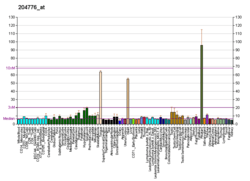Thrombospondin 4
Thrombospondin-4 is a protein that in humans is encoded by the THBS4 gene.[5][6]
The protein encoded by this gene belongs to the thrombospondin protein family. Thrombospondin family members are adhesive glycoproteins that mediate cell-to-cell and cell-to-matrix interactions. This protein forms a pentamer and can bind to heparin and calcium. Studies of the rat counterpart suggest that this protein may be involved in local signaling in the developing and adult nervous system.[6]
References
- 1 2 3 GRCh38: Ensembl release 89: ENSG00000113296 - Ensembl, May 2017
- 1 2 3 GRCm38: Ensembl release 89: ENSMUSG00000021702 - Ensembl, May 2017
- ↑ "Human PubMed Reference:".
- ↑ "Mouse PubMed Reference:".
- ↑ Lawler J, McHenry K, Duquette M, Derick L (Mar 1995). "Characterization of human thrombospondin-4". J Biol Chem. 270 (6): 2809–14. doi:10.1074/jbc.270.6.2809. PMID 7852353.
- 1 2 "Entrez Gene: THBS4 thrombospondin 4".
Further reading
- Arber S, Caroni P (1996). "Thrombospondin-4, an extracellular matrix protein expressed in the developing and adult nervous system promotes neurite outgrowth". J. Cell Biol. 131 (4): 1083–94. doi:10.1083/jcb.131.4.1083. PMC 2200004. PMID 7490284.
- Lawler J, Duquette M, Urry L, et al. (1993). "The evolution of the thrombospondin gene family". J. Mol. Evol. 36 (6): 509–16. doi:10.1007/BF00556355. PMID 8350346.
- Lawler J, Duquette M, Whittaker CA, et al. (1993). "Identification and characterization of thrombospondin-4, a new member of the thrombospondin gene family". J. Cell Biol. 120 (4): 1059–67. doi:10.1083/jcb.120.4.1059. PMC 2200072. PMID 8432726.
- Newton G, Weremowicz S, Morton CC, et al. (2000). "The thrombospondin-4 gene". Mamm. Genome. 10 (10): 1010–6. doi:10.1007/s003359901149. PMID 10501972.
- Carron JA, Hiscott P, Hagan S, et al. (2001). "Cultured human retinal pigment epithelial cells differentially express thrombospondin-1, -2, -3, and -4". Int. J. Biochem. Cell Biol. 32 (11–12): 1137–42. doi:10.1016/S1357-2725(00)00065-0. PMID 11137453.
- Luo J, Dunn T, Ewing C, et al. (2002). "Gene expression signature of benign prostatic hyperplasia revealed by cDNA microarray analysis". Prostate. 51 (3): 189–200. doi:10.1002/pros.10087. PMID 11967953.
- Strausberg RL, Feingold EA, Grouse LH, et al. (2003). "Generation and initial analysis of more than 15,000 full-length human and mouse cDNA sequences". Proc. Natl. Acad. Sci. U.S.A. 99 (26): 16899–903. doi:10.1073/pnas.242603899. PMC 139241. PMID 12477932.
- Congote LF, Difalco MR, Gibbs BF (2004). "The C-terminal peptide of thrombospondin-4 stimulates erythroid cell proliferation". Biochem. Biophys. Res. Commun. 324 (2): 673–8. doi:10.1016/j.bbrc.2004.09.107. PMID 15474480.
- Gerhard DS, Wagner L, Feingold EA, et al. (2004). "The status, quality, and expansion of the NIH full-length cDNA project: the Mammalian Gene Collection (MGC)". Genome Res. 14 (10B): 2121–7. doi:10.1101/gr.2596504. PMC 528928. PMID 15489334.
- van Doorn R, Zoutman WH, Dijkman R, et al. (2005). "Epigenetic profiling of cutaneous T-cell lymphoma: promoter hypermethylation of multiple tumor suppressor genes including BCL7a, PTPRG, and p73". J. Clin. Oncol. 23 (17): 3886–96. doi:10.1200/JCO.2005.11.353. PMID 15897551.
- Stenina OI, Ustinov V, Krukovets I, et al. (2006). "Polymorphisms A387P in thrombospondin-4 and N700S in thrombospondin-1 perturb calcium binding sites". FASEB J. 19 (13): 1893–5. doi:10.1096/fj.05-3712fje. PMID 16148025.
- Misenheimer TM, Mosher DF (2006). "Biophysical characterization of the signature domains of thrombospondin-4 and thrombospondin-2". J. Biol. Chem. 280 (50): 41229–35. doi:10.1074/jbc.M504696200. PMC 2219889. PMID 16246837.
- Cui J, Randell E, Renouf J, et al. (2006). "Thrombospondin-4 1186G>C (A387P) is a sex-dependent risk factor for myocardial infarction: a large replication study with increased sample size from the same population". Am. Heart J. 152 (3): 543.e1–5. doi:10.1016/j.ahj.2006.06.002. PMID 16923428.
- Cáceres M, Suwyn C, Maddox M, et al. (2007). "Increased cortical expression of two synaptogenic thrombospondins in human brain evolution". Cereb. Cortex. 17 (10): 2312–21. doi:10.1093/cercor/bhl140. PMID 17182969.
This article is issued from
Wikipedia.
The text is licensed under Creative Commons - Attribution - Sharealike.
Additional terms may apply for the media files.




